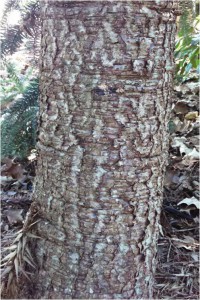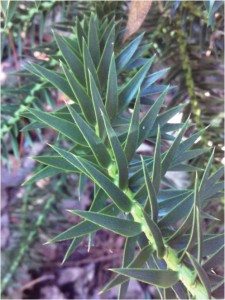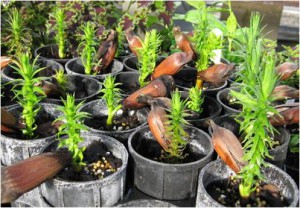Paraná Pine, Araucaria angustifolia:
An ancient-looking conifer for modern landscapes
Paraná pine is a primitive-looking conifer valued for its unusual horizontal branching, sharply pointed triangular needles and neat, symmetrical form. The primitive appearance of this evergreen tree results from its resemblance to and relationship with an ancient group of conifers that dominated forests more than 65 million years ago.
Not a true pine, this dark green tree has a narrow, pyramidal shape when young. Paraná pine is considered fast-growing, and a tree planted at Gardens of the Big Bend in Quincy, Florida, reached a height of 30 feet and a width of 14 feet in eight years (Fig. 1).
Paraná pine reaches a mature size of 60 to 115 feet after 50 to 90 years or more in forests of southern Brazil. As it approaches maturity, the lower branches gradually die and the tree develops a dramatic dome shaped crown that somewhat resembles a candelabra due to upward pointing branch tips. Paraná pine is considered a large, long-lived tree. Fully mature trees may be 140 to 250 years of age, have heights up to 160 feet, and trunk diameters exceeding three feet (Fig. 2).
This evergreen conifer has distinctive sharp-pointed, tough, scale-like needles (Fig. 3). The dark green needles are triangular shaped and about 1 to 2.5 inches long. Needles tend to be tufted at outer ends of stiff, horizontally held branches. Needles persist for up to 15 years and cover all plant parts except the trunk and major branches. The stiff, sharp needles make the tree and branches difficult to handle, while also acting as a deterrent to deer feeding and other animal predation as well as foot traffic.
Paraná pine is usually dioecious, meaning male and female flowers are borne on separate plants. Pollen cones are oblong, up to seven inches long and about one inch wide at the time of pollen release. Wind carries pollen to female plants bearing seed cones. Young female trees begin to set seed between 12 and 15 years of age. After pollination, seed cones mature about 18 to 36 months later, usually in fall. Seed cones are brown, globe shaped, 7 to 10 inches in diameter, and are usually found in the upper canopy of trees. Each cone holds about 100 to 150 two inch nut-like, narrowly winged seeds (Fig. 4). Cones fall when mature and break apart, dispersing seeds that germinate soon thereafter. Seeds are eaten by mammals and birds, thus also dispersing seeds.
This tree once covered vast areas of subtropical forests in southern Brazil and neighboring portions of Argentina and Paraguay. Native Americans gathered cones to harvest the seeds for food. European settlers recognized Paraná pine as an important timber tree and it was logged extensively through the 20th century. Paraná pine now is one of the rarest trees in Brazil and is considered critically endangered due to a declining population caused by habitat loss and exploitation. In recognition of the past importance of Paraná pine, this tree is the symbol for the Brazilian State of Paraná.
The seeds, locally called pinhões, are still a prized food in Brazil. The seeds are similar to large pine nuts and are eaten after roasting or cooking in salt water.
Other common English names for Paraná pine are Brazilian pine and candelabra tree. Common Portuguese names for Araucaria angustifolia are pinheiro-do-Paraná, pinheiro, araucária, pinho, pinho Brasileiro, pinheiro Brasileiro, pinheiro são josé, pinheiro macaco, pinheiro caiová, pinheiro das missões, curi, and curiúva. Common Spanish names are pino blanco and pino de Missiones.
Despite the common names, Paraná pine is not a pine (Pinus spp.) and instead is related to the Monkey-puzzle tree (Araucaria araucana;), Bunya-bunya tree (Araucaria bidwillii;), and the Norfolk Island pine (Araucaria heterophylla;), commonly encountered in southern Florida.
Paraná pine is sometimes confused with China fir (Cunninghamia lanceolata;), another large conifer commonly encountered in old landscapes along the Gulf Coast and north Florida. China fir differs in having pointed needles, bright green coloring, and a broader, irregular pyramidal form.
Paraná pine prefers well drained, slightly acidic soil in sun or light shade. It grows best in a mild, warm temperate climate typical of USDA Cold Hardiness Zones 7-9, and can tolerate occasional severe freezes. Paraná pine transplants well: a tree at Gardens of the Big Bend (Quincy, FL) was moved by tree-spade after four years. Subsequent growth continued at the same rate as before moving. Pests and diseases have not been reported.
Seeds must be obtained fresh and are viable for only about six weeks. Typically, freshly harvested seeds are ordered from Brazil and planted soon after being received. Seeds germinate easily within three months of sowing (Fig. 5).
As a “living fossil”, Paraná pine is prized for its unusual appearance, horizontal branching and dark green color. This evergreen conifer grows too large for most residential situations. Paraná pine is best used as an accent or conversation piece in arboreta, botanic gardens, parks, campuses, golf courses and other large-scale landscapes.
- Foodscaping – Create Beauty and Bounty - April 7, 2022
- Cold-hardy Bromeliads for North Florida - December 15, 2021
- How to Hunt for “New” Plants - September 2, 2021





